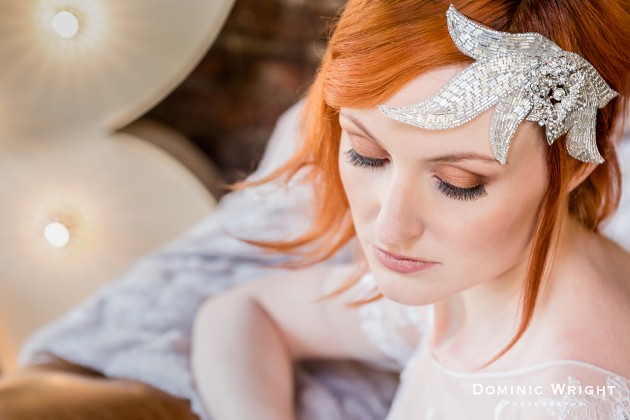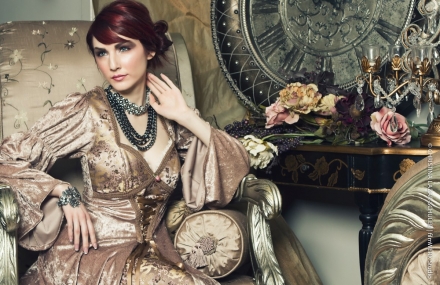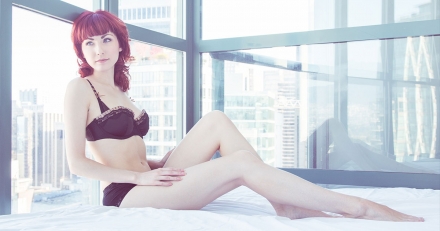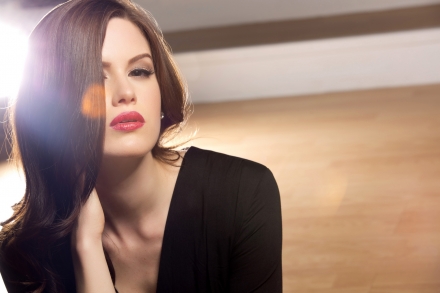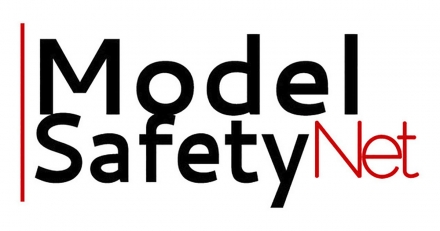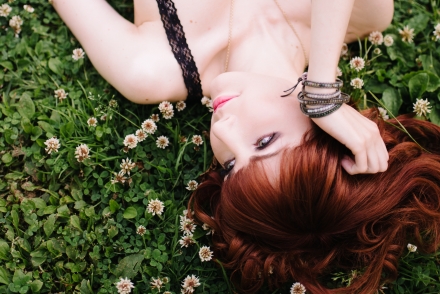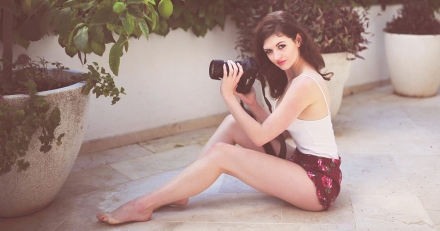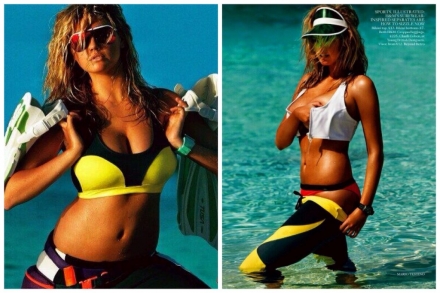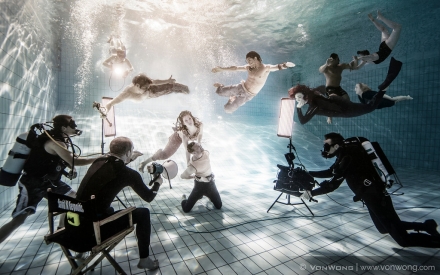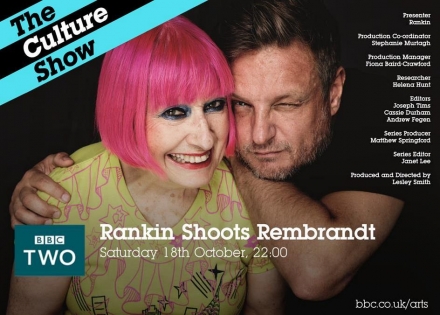Anita De Bauch is a British model and writer. Wearing everything from Vivienne Westwood to latex couture, her modelling spans fashion, commercial, art nude, and vintage modelling. We caught up with Anita about her career, writing and advice for young models.
What got you started as a model?
Dita Von Teese’s book ‘Burlesque and the Art of the Teese’ is what first inspired me to actually try modelling nearly eight years ago, and along with my now quite decent library of vintage photo books and glamour icon biographies, has been a part of my creative make-up ever since. I might never have tried to make a living from doing and being what I love if it weren’t for this amazing lady! I started using model networking sites to find photographers willing to shoot me on a TFP basis to make my first portfolio, after which I started being offered paid work.
What did you study at school, and what were the most useful subjects in retrospect?
Psychology and Business Studies were very useful because they helped me feel more familiar and confident about being self-employed and marketing myself. I already understood basic things like the difference between being a ‘sole trader’ and a ‘private limited company’ and some basics to do with sales psychology and so on before I started my first business, shortly after my eighteenth birthday. English was also important, for writing to clients as well as writing ads; no-one takes you seriously when you’re a kid unless you sound like a grown-up in correspondence. Being able to do basic maths in your head is helpful for pricing up jobs on the spot. I also think studying GCSE Graphics was helpful for designing my website and comp cards.

Photograph by Stephen Perry
Were there any times you felt like quitting? How did you manage when you were starting out?
I never had a ‘big break’ where I was suddenly catapulted to success – what I have now, I worked very hard for. I’ve had some tough times, for sure. Income for all freelance people is unpredictable, not just for models, but it’s even worse before you get established. You can go from having a super busy month, or your first sell-out tour, or a month where you happen to get published a lot, or whatever, and think, “Finally! I’ve made it! I have arrived!” and then next month you’re spending everything you saved last month on bills because no-one booked you, which is rather deflating. I’ve had times living in London years ago when I literally couldn’t even afford the tube fare to get to shoots and had to ask the photographers for a “deposit” in advance so I could actually get there! I was grateful to anyone who brought sandwiches to those shoots, that’s for sure.
I spent many of my first winter evenings in London eating dinner in bed because I couldn’t afford to switch on the heating, too. I spent the time reading the biographies of 20th century glamour icons from Marlene Dietrich to Izzy Blow, watching inspiring movies, and endlessly researching models, photographers, designers, and makeup techniques online, doing hundreds of sit-ups, and reading about nutrition. When an opportunity does present itself, you often don’t get much notice, so it’s good to be ready to spring into action. I’m proud of where I came from and excited about publishing a book, buying my own house and the car I’ve always wanted over the next few months, all thanks to modelling. Hard work does pay off, but to be honest, I’d hope to be doing this stuff in my late twenties anyway, whatever my profession. I’m just happy that I got here by doing what I love.

Photograph by Callan Tham
How long did it take you to achieve financial stability from modelling?
I was modelling for a whole year before I started charging, but then, I never thought initially that it could be anything more than a hobby for me. I was thrilled when photographers started asking for my “rates”! It can take a lot less time than this if you have the know-how. I guided a friend of mine every step from never having modelled before to regularly booking paid work as a part-time income in less than five months, even though she wasn’t typical fashion agency material in terms of height and so on. It’s all about playing to your strengths – everyone has them – and combining this with practical knowledge of how things work in the real world. The process inspired me to take note of what I was doing and the material I wrote for her makes up part of The “Ugly” Girl’s Guide to Modelling.
Did you have a backup plan? What career would you have now if you weren’t a model?
I don’t even like to think about that. I’d probably be living under a bridge and drawing pictures in the dirt. Or sitting on the side of the road with a cardboard sign round my neck reading ‘WILL MODEL FOR BEER’. Modelling is the only full-time job I’ve ever had, so I really don’t know about anything else.

Photograph by Adrian Jones
What events and traits do you think helped you get where you are now?
I really wanted to learn how to be a good model. I never thought I had all the answers, and I still don’t. I was and am always open to doing whatever it takes to become better at modelling. If you’re not willing to learn then you’ll be a beginner all your life. I love self-improvement projects. I took a Method acting class to improve my facial expressions, ballet lessons to improve my posture and hand gestures, and a TV presenting course to learn how to talk to camera. I do Yoga to improve balance and flexibility, Pilates to improve muscle tone and core strength and I eat and sleep well. I still practise a few poses and expressions in the mirror every time I go to the bathroom. If you add that up over an eight year period, that’s a lot of practice!
Of course it’s helpful if you’re naturally photogenic in the sense of the current vogue (tall, slim, white, young, long hair, high cheekbones etc) but I wouldn’t say it’s crucial for at least earning a part-time living as a model. If you’re determined and a quick learner, you can usually fake whatever the look the client is after with clever posing, hair and makeup styling. The most important thing is being dedicated, and you can only be dedicated if you really are into modelling, otherwise it gets boring very quickly as it is awfully hard work. As well as being punctual and professional at shoots, and actually good at modelling, which is an acquired skill, you need to eat right, work out, sleep plenty and network every day, or at least, most days, and no-one pays you for that stuff. That’s why it’s impossible for models to shoot for minimum wage. I recently worked out that it effectively costs me around £50 or so to do a shoot, and that’s before any train tickets or whatever are factored in, so I charge £50ph with a minimum booking of 2 hours.
How has your modelling evolved over time?
I started by mostly shooting retro pin-ups and burlesque themed shots. I was lucky because ‘burlesque’ was starting to gain really mainstream popularity in the UK in 2006 and lots of photographers wanted that look for the portfolios, so I had a whale of a time dressing up in rhinestone bikinis and messing about with feather fans that I had no idea how to dance with (and still don’t). I always wanted to shoot latex, so once I’d saved enough from my pin-up shoots to buy a modest wardrobe of second hand designer latex from other models, I started doing that, too. Nowadays I shoot all styles from fashion to art nude levels. I’m still known for my vintage glamour and fetish modelling but do equal parts art nude, beauty, fashion and commercial, too.

Photograph by Luci Alice
What made you choose to specialise in your preferred genre?
I think I’m known best for my latex work, which I make my own by blending with elements of vintage glamour from the 1920s, 30s, 40s and 50s. Rubber is fun to wear and I like the idea of finding ways to make myself feel really attractive while wearing it. Latex modelling is still going strong for me, but I recognise that it won’t last forever, so I’m trying to concentrate now on building a really watertight commercial, art nude and vintage glamour portfolio for when I hit 35 or so and fewer people want to see me in latex. It’s seven years away, but it’s never too early to prepare!
What made you decide to live in London?
It was very important for me to move to London early on in my career because it is the centre of fashion and the arts in the UK, and also happens to be my favourite fashion capital of the world. About half my bookings are in London and the southeast. When I first moved to London, I had only been modelling part-time for a year, and my rates were very low, so the only way I could get enough work to live on was to live amongst the work. I still love London and I’m constantly inspired by the rich history, diverse designers, restaurant and art scenes, and the nightlife. One can never be truly stylish without visiting London regularly.

Photograph by Stephen Perry
Tell us about some of your international shoots.
Earlier this year I was booked by Olympus cameras to model for a kind of promotional demo they were doing at a trendy young event in Helsinki. The photographer demonstrating what the cameras can do was one of their brand ambassadors, Damian McGillicuddy, who I happen to have been working with for years, now. He did some of my early TFP shoots when I was just starting out and did a lot to boost my confidence as a model. We even found time in Helsinki to shoot some photos for ourselves, as well as the client. It’s easier to work abroad when a client is flying you out, putting you up, feeding you and so on, but it’s a double-edged sword because a lot of the time they don’t want you to shoot with anyone else while you’re there, whereas if you’re arranging your own tour and paying your own way, you get to do exactly what you want. I like to do a mixture, some foreign trips courtesy of individual clients and some self-organised tours.
From October onwards I’ll be touring more than usual, all over the UK, Ireland, Europe and Asia, so I will be able to work with pretty much anyone who is interested, anywhere. That’s pretty major and I’m taking bookings now.

Photograph by Damian McGillicuddy
Being a model isn’t as glamorous as the finished photos suggest. What are the best and worst things about being a model?
No job is 100% wonderful all the time, but modelling is still one of the most glamorous, for sure. I love getting my hair and makeup done, seeing the photos, seeing the amazing sets and beautiful locations, jetting around the world, meeting celebrities, meeting fans, wearing amazing clothes, and so on. On the other hand, I work a 60 hour week and much of that is spent in front of my laptop writing emails, advertising and networking. I try to do it in a glamorous way though! I like to wear some of my vintage 1930s silk Chinoiserie loungewear, make a pot of exotic tea, light scented beeswax candles and so on when working from home. It just makes the whole experience more pleasant, especially if you end up sitting in the same chair for 12 hours trying to keep up with various demands!
Which do you prefer, studio shoots, room shoots, or outdoor location shoots?
I generally prefer location work to studio, even though shooting on location is always a little more challenging. Maybe I like that the environment is less controlled. I certainly like to react to the environment, interact with it, and let it flow into my posing. You don’t get that in a studio, although you do get a roof, a heater and a changing room with somewhere to plug in your tongs, so it’s a trade-off. I love to shoot in really ornate, opulent rooms that give that deep glamour vibe.

Photograph by Stephen Perry
What advice would you give models starting out?
I got asked this so many times, and there is just so much to say, that I literally ended up writing a book about it. There just isn’t a decent book about internet modelling for UK models out there right now. It’s called The Ugly Girl’s Guide to Modelling, a satire on the idea that if you can’t get into an agency, then you’re too ‘ugly’ to model, which simply isn’t true. August this year was spent working closely with my publisher, editing the book, and designing the layout. I like to be the best at what I do, and if I’m not the best, I don’t do it at all. I don’t kid myself. Creating this book has been an intense experience because I’ve never written a book before and yet I want mine to be the best of its kind. I wanted it to be cute and feminine and look gorgeous lying around in someone’s bedroom, but then it’s no good filling up a modelling guide with lots of pretty pictures and boasting about what you’ve achieved and not actually give people the real talk that they can’t just find online about how to make money. I’m putting the finishing touches to it now, so hopefully it should be out soon. It’s pretty comprehensive and covers everything from networking and maximising profits to how to pose to make your ass look smaller. I really wish I’d had a copy when I was starting out.
What’s it like being signed with an agency versus being a freelance model?
I’m signed to two agencies; one commercial and one alternative, but neither has found me much work yet. I make my living by working freelance. I like to have direct contact with the client leading up to the shoot. It’s much more efficient for getting things organised and means we already have some sort of working relationship before we even start shooting, which is nice. I also like not having to give anyone 20% of my earnings.

Photograph by Perou
Do you have any particular models and photographers who really inspire you?
I’ve been thrilled this year by meeting two of my personal modelling icons, Dita Von Teese in New York, and Twiggy in London. Getting to watch them at work gave me chills, and you can bet I was taking a million mental notes! They are both petite ladies who pursued what made them different to other models, rather than trying to blend in, or copy what other people were doing. It takes such emotional strength and courage to do that! Their stories are inspiring because they worked it and became supermodels. They are also absolutely lovely, sweet, friendly people!
Perou has been probably my earliest favourite photographer, and his work with Dita Von Teese and Marilyn Manson are a major part of what made me want to start modelling in the first place. I was at home pointing at my computer screen, like, “Oh my god, I want to do THAT! That is want I want to do!” It just looked like the best thing ever, and it kind of is, really. He contacted me privately to invite me to a party and as soon as we met there, the first thing we did was arrange a shoot. We worked together last year, which was one of those real pinch-me-am-I-dreaming moments in my career, and the pictures were awesome. It was just perfect.
If you could re-create any famous photo, which would it be, and what would you do differently to make it your own?
I have a whole library of photo books for inspiration as well as folder on my computer, but I don’t really try to replicate individual photos. Other than copying the pose, I wouldn’t be able to anyway, really, as it’s not me who decides the lighting, setting or camera angles. I more try to project characters generally; if I’ve just seen a really cool character in a movie or read about someone really stylish I imagine how they would pose, and just allow myself to get caught up in it. It’s fun.

Photograph by Andrew McNeekin
Where do you see your modelling career going?
I was told I’d be too old by 22, yet here I am at 28 having my most successful year so far. I suspect I can keep it up until my mid-thirties… after that I would probably have to adapt what I do a little to suit my age, but probably not much. I don’t think I’ll have to change the way I style myself much between now and the age of 60 – long hair, red lips, a healthy body and well-tailored clothes look good at any age. I might have to start cutting back on the latex a little at 35… but I expect I will be suitable for more commercial and advertising work at that point, when I look a little more ‘mature’! We’ll have to see, won’t we?
What are your views on nudity?
It’s a shame that I still get asked for my opinion on nude modelling, because it shows that it is still a controversial topic. No-one ever asks my opinion on clothed modelling. I just call it all modelling and have done with it. I certainly find some websites’ policy of allowing photos of male nipples but not female nipples downright offensive. Female bodies are no ruder than male. It’s actually quite scary that we have to keep pointing that out. And if someone looks at a picture of a female nipple and feels sexually aroused, that’s great. Why would that be a bad thing?
You were involved in shooting Jessie J’s video ‘It’s My Party’. What was that like?
Amazing. I got picked up from my house at 4am and driven to Malcolm Ryan Studios to shoot the video. The wardrobe team liked the outfit I wore to the audition so much that they asked me to wear it in the video. It’s been a while since I teamed a black fishnet top with a dog collar, but turns out, it’s like riding a bike. I did get a cool biker jacket to wear in one scene, in fact, so I could give it to Jessie at our punk party. It’s a gorgeous jacket, but I was glad to be rid of it; it was SO hot to rave for 16 hours under the boiling hot studio lights in a leather coat! Jessie’s professionalism genuinely blew my mind. She had 100% energy on the first take, 100% energy on the second take, 100% energy on the nineteenth take. Her voice is really amazing. It trickles completely freely and naturally, like running water, yet is held in perfect and light control. I don’t think her records really show what she can do, maybe because then they’d be a bit much for the average pop fan to handle! I bet she’s good live, though.
Tell us about your social media habits, and top tips
I sign up to more or less everything if it’s free, and link various profiles together to save time. When I post a photo on Instagram, it automatically appears on Tumblr, which automatically uploads the image to my Twitter, and so on. Then if I want to go back and add something to just one profile, like my Facebook page, I can. I try and post at least one photo a day – I am a model, after all! And I try to reply to as many people as possible who contact me through social media, even if it’s just a quick ‘hello’ or a retweet. I think it’s probably helpful to have the same handle on all the sites you’re on, to make you as easy as possible for fans to find. I try not to post anything too boring or unglamorous! Who wants to read that?
What do you like best about Portfora so far?
The admin, who actually respond to messages – and respond politely and helpfully! The whole atmosphere of a site is set by those in charge, which explains why some of the others are so dire.
Anything else you’d like to say?
If you want to see more of my latest photos and thoughts, please subscribe to my blog!
You can view more photos in Anita’s portfolio on Portfora. We’ll be posting an article about Anita’s book on modelling, ‘The Ugly Girl’s Guide to Modelling’, along with excerpts and tips, as soon as it’s published.







